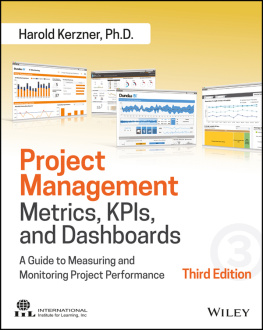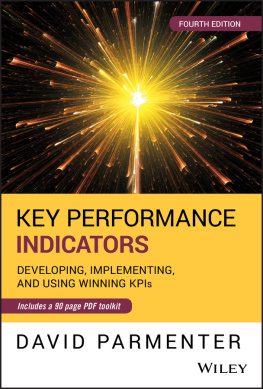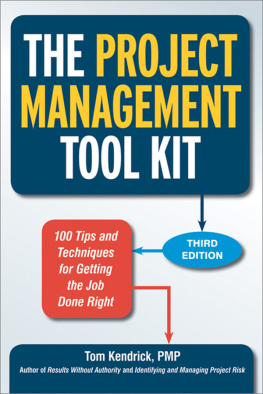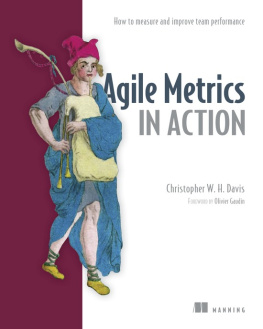
Cover design: Wiley
Cover image: 2017 Dundas Data Visualization, Inc. All rights reserved.
This book is printed on acid-free paper.
Copyright 2017 by International Institute for Learning, Inc., New York,
New York. All rights reserved.
Published by John Wiley & Sons, Inc., Hoboken, New Jersey
Published simultaneously in Canada
No part of this publication may be reproduced, stored in a retrieval system, or transmitted in any form or by any means, electronic, mechanical, photocopying, recording, scanning, or otherwise, except as permitted under Section 107 or 108 of the 1976 United States Copyright Act, without either the prior written permission of the Publisher, or authorization through payment of the appropriate per-copy fee to the Copyright Clearance Center, 222 Rosewood Drive, Danvers, MA 01923, (978) 750-8400, fax (978) 646-8600, or on the web at www.copyright.com. Requests to the Publisher for permission should be addressed to the Permissions Department, John Wiley & Sons, Inc., 111 River Street, Hoboken, NJ 07030, (201) 748-6011, fax (201) 748-6008, or online at www.wiley.com/go/permissions.
Limit of Liability/Disclaimer of Warranty: While the publisher and author have used their best efforts in preparing this book, they make no representations or warranties with the respect to the accuracy or completeness of the contents of this book and specifically disclaim any implied warranties of merchantability or fitness for a particular purpose. No warranty may be created or extended by sales representatives or written sales materials. The advice and strategies contained herein may not be suitable for your situation. You should consult with a professional where appropriate. Neither the publisher nor the author shall be liable for damages arising herefrom.
For general information about our other products and services, please contact our Customer Care Department within the United States at (800) 762-2974, outside the United States at (317) 572-3993 or fax (317) 572-4002.
Wiley publishes in a variety of print and electronic formats and by print-on-demand. Some material included with standard print versions of this book may not be included in e-books or in print-on-demand. If this book refers to media such as a CD or DVD that is not included in the version you purchased, you may download this material at http://booksupport.wiley.com. For more information about Wiley products, visit www.wiley.com.
Library of Congress Cataloging-in-Publication Data
Names: Kerzner, Harold, author.
Title: Project management metrics, KPIs, and dashboards : a guide to
measuring and monitoring project performance / Harold Kerzner, Ph.D., Sr.
Executive Director for Project Management, The International Institute for
Learning.
Description: Third edition. | Hoboken, New Jersey : John Wiley & Sons, Inc.,
[2017] | Includes index. |
Identifiers: LCCN 2017022057 (print) | LCCN 2017030981 (ebook) | ISBN
9781119427506 (pdf) | ISBN 9781119427322 (epub) | ISBN 9781119427285 (pbk.)
Subjects: LCSH: Project management. | Project managementQuality control. |
Performance standards. | Work measurement.
Classification: LCC HD69.P75 (ebook) | LCC HD69.P75 K492 2017 (print) | DDC
658.4/04dc23
LC record available at https://lccn.loc.gov/2017022057
Preface
The ultimate purpose of metrics and dashboards is not to provide more information but to provide the right information to the right person at the right time, using the correct media and in a cost-effective manner. This is certainly a challenge. As computer technology has grown, so has the ease with which information can be generated and presented to management and stakeholders. Today, everyone seems concerned about information overload. Unfortunately, the real issue is non-information overload. In other words, there are too many useless reports that cannot easily be read and that provide readers with too much information, much of which may have no relevance. This information simply distracts us from the real issues and accurate performance reporting. Furthermore, the growth in metric measurement techniques has encouraged us to measure everything regardless of its value as part of performance reporting.
The purpose of status reporting is to show us what actions the viewer must consider. Insufficient or ineffective metrics prevent us from understanding what decisions really need to be made. In traditional project review meetings, emphasis is placed on a detailed schedule analysis and a lengthy review of the cost baseline versus actual expenditures. The resulting discussion and explanation of the variances are most frequently pure guesswork. Managers who are upset about the questioning by senior management then make adjustments that do not fix the problems but limit the time they will be grilled by senior management at the next review meeting. They then end up taking actions that may be counterproductive to the timely completion of the project, and real issues are hidden.
You cannot correct or improve something that cannot be effectively identified and measured. Without effective metrics, managers will not respond to situations correctly and will end up reinforcing undesirable actions by the project team. Keeping the project team headed in the right direction cannot be done easily without effective identification and measurement of metrics.
When all is said and done, we wonder why we have studies like the Chaos Report, which has shown us over the past 20 years that only about 30 percent of the IT projects are completed successfully. We then identify hundreds of causes as to why projects fail but neglect what is now being recognized as perhaps the single most important cause: a failure in metrics management.
Metrics management should be addressed in all of the areas of knowledge in the PMBOK Guide, especially communications management. We are now struggling to find better ways of communicating on projects. This will become increasingly important as companies compete in a global marketplace. Our focus today is on the unique needs of the receiver of the information. The need to make faster and better decisions mandates better information. Human beings can absorb information in a variety of ways. We must address all of these ways in the selection of the metrics and the design of the dashboards that convey this information.
The three most important words in a stakeholders vocabulary are making informed decisions. This is usually the intent of effective stakeholder relations management. Unfortunately, this cannot be accomplished without an effective information system based on meaningful and informative metrics and key performance indicators (KPIs).
All too often, we purchase project management software and reluctantly rely on the report generators, charts, and graphs to provide the necessary information, even when we realize that this information either is not sufficient or has limited value. Even those companies that create their own project management methodologies neglect to consider the metrics and KPIs that are needed for effective stakeholder relations management. Informed decisions require effective information. We all seem to understand this, yet it has only been in recent years that we have tried to do something about it.
For decades we believed that the only information that needed to be passed on to the client and the stakeholders was information related to time and cost. Today we realize that the true project status cannot be determined from time and cost alone. Each project may require its own unique metrics and KPIs. The future of project management may very well be metric-driven project management.
Next page







